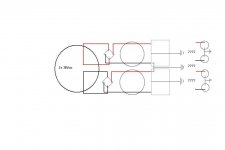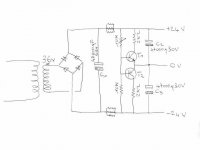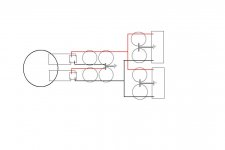bobodioulasso said:If you put 2 seconds dc at input, you find 2 seconds amplified dc at the output. Where is the problem? May be i was not so clear.
I was saying i did not test dc applied for a long time, that's all.
I have no problem with this amp, just making tests to try to better understand how works this PSU. As you were asking me questions...
permaneder said:Dan,
If you inject DC voltage into the input of an F5, you'll always find amplified DC (+ 15dB approx.) at the output, of course. Your amp doesn't care whether the signal is AC or DC.
gm
Sorry Guys my mistake... i thought you meant there was dc on the output with no signal. my excuse is too much work not enough coffee 🙂
-Dan
Tinitus,
The ClassA is a current limit.
If you load the amplifier with a lower resistance/impedance one will reach that current limit at exactly the same current.
The ClassA is a current limit.
If you load the amplifier with a lower resistance/impedance one will reach that current limit at exactly the same current.
tinitus said:From what I understand with such rather small classA...
What seems to me:
Parallel operation doubles the output current available into the load.
Into 8 ohms, each amp is able to deliver 2.5Amp (classA 1.25A bias)
Total 5A class A into 8ohms .
5Ax5Ax8ohms=200w max=100w rms.
Bridging operation is another story which doubles the output voltage available into the load.
Correct me, please, if i am wrong.
f5II psw
Bobodioulsso-
Thanks for your insight
I think we have a winner- I am wrong to try to use these transformers for this project-drat!
Saving pennies for two Antek Trannies-
Again, I appreciate everyones thoughts in discussing this design connondrum
rob
Bobodioulsso-
Thanks for your insight
I think we have a winner- I am wrong to try to use these transformers for this project-drat!
Saving pennies for two Antek Trannies-
Again, I appreciate everyones thoughts in discussing this design connondrum
rob
HIbobodioulasso said:
What seems to me:
Parallel operation doubles the output current available into the load.
Into 8 ohms, each amp is able to deliver 2.5Amp (classA 1.25A bias)
Total 5A class A into 8ohms .
5Ax5Ax8ohms=200w max=100w rms.
Bridging operation is another story which doubles the output voltage available into the load.
Correct me, please, if i am wrong.
Your calculation are OK except you need at least +-44V rails to get 100Wrms at 8 ohms, i.e. Vpeak~44-4 =40 , Prms=40x40/8 = 200/2=100Wrms. If you have 24V rails i.e. 20 peak due to losses you will still get 25rms at 8 ohm, but for 4 ohm you will have not 12wrms class A (50WRMS CLASS B) as before , but 50 Wrms. Prms 20X20/4=100/2=50Wrms and all these to FULL class A
and if that 5Apk is a transient current into a reactive speaker load then it can be demanded by the speaker and delivered by a +-24Vdc supply.
kzeprf22 said:
HI
Your calculation are OK except you need at least ...
You are right, thanks.
My calculation was only stating the class A limit, not the real available power limit imposed by supply rails voltage.
So, as you said, the interest of parallel operation is to allow 50W class A into a 4 ohms load. And also more available class A power into complex/reactive loads .
tinitus said:Would this supply work for balanced amp
Cant figure out what happens to grounds
you really didn't look in any FW manual ?
one can't drew it simpler than Papa already does
all you need is to read
tinitus said:Would this supply work for balanced amp
I use this one.(see post 4239)
Scroll down to Quad 606 schematic
http://quad405.com/
Of coarse you can double it if you have no 2x18v xformer but a 2x38 one.
If you did not get yet any transormer, it is simpler to do as Nelson recommends.
Attachments
Ok, all I can find is information that a F4 stereo amp can be bridged into a monoamp
I as wondering whether there would be better ways to build supply if only balanced function was wanted
Well, I dont think I will mess with this, and just use my big trafos for ordinary AB
I as wondering whether there would be better ways to build supply if only balanced function was wanted
Well, I dont think I will mess with this, and just use my big trafos for ordinary AB

tinitus said:Ok, all I can find is information that a F4 stereo amp can be bridged into a monoamp
That's the reason for the IMPASSE Balanced Pre.
tinitus said:Ok, all I can find is information that a F4 stereo amp can be bridged into a monoamp
Balanced versions have been discussed in early pages.
For instance, go to Post #1255 p51 and around.
tinitus said:I as wondering whether there would be better ways to build supply if only balanced function was wanted.
Not really. Offhand I can't think of anything special you would do that
wouldn't apply to the non-balanced version.
😎
Ok, thanks
Each board their own respective supply
Ofcourse, I remember it now, true balanced it is🙂
ehhh, maybe its really best when both boards share the same supply, or at least same trafo, and have no issues with any small differences, knowing that balanced could be critical to tolerances
And the possibility to turn it into a normal stereo could be a nice option too
This could make me rethink my usual favour of building monos 🙄 have to think about it
Each board their own respective supply
Ofcourse, I remember it now, true balanced it is🙂
ehhh, maybe its really best when both boards share the same supply, or at least same trafo, and have no issues with any small differences, knowing that balanced could be critical to tolerances

And the possibility to turn it into a normal stereo could be a nice option too
This could make me rethink my usual favour of building monos 🙄 have to think about it
Another stupid question 
Problems with low impedance is usually in the bass region
Will it be audible if amp leaves classA at low frequencies
If amp leaves classA at say 50-100hz, will it also leave classA at higher frequencies as well, even if it delivers power well within the classA operation at say 1000hz 🙄

Problems with low impedance is usually in the bass region
Will it be audible if amp leaves classA at low frequencies
If amp leaves classA at say 50-100hz, will it also leave classA at higher frequencies as well, even if it delivers power well within the classA operation at say 1000hz 🙄
tinitus said:Another stupid question
Will it be audible if amp leaves classA at low frequencies
If amp leaves classA at say 50-100hz, will it also leave classA at higher frequencies as well, even if it delivers power well within the classA operation at say 1000hz 🙄
Not sure of both on those questions. I would think if there is only bass then it wouldn''t be audible. However, if you've seen a complex wave on a scope and there is high frequency mixed with the bass then it would seem like the whole output stage would leave class A. Maybe this is where intermodulation distortion becomes a problem.
tinitus said:
If amp leaves classA at say 50-100hz, will it also leave classA at higher frequencies as well, even if it delivers power well within the classA operation at say 1000hz 🙄
Simplicity is not that simple . . . ?
Or trying to make simple things be complicated . . . ?
A music signal wave is mixture of many different frequencies . . .
If any point of the envelop curve (formed by peak points) of the music signal is cutting and leaving Class A bias, the music signal is leaving the Class A bias. Remember that the music signal wave is mixture of many different frequencies . . . I believe you know all already, don't you . . .
🙂
While the topic is warm.
I was wondering:
A balanced F5 feeding a 8 ohm load leaves class A at 2.5A/ 25W? Is that right?
If so, balanced operation only gives more class AB power.
May be should i read more FW manuals...
I was wondering:
A balanced F5 feeding a 8 ohm load leaves class A at 2.5A/ 25W? Is that right?
If so, balanced operation only gives more class AB power.
May be should i read more FW manuals...
- Home
- Amplifiers
- Pass Labs
- F5 power amplifier


